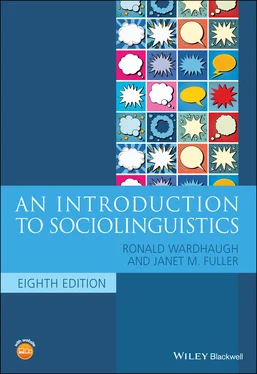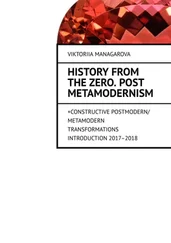Further, our identities are fluid and we do not have a single identity but multiple levels of identity, and shifting and sometimes even conflicting identities which emerge in different contexts. To continue the example above, the speaker may reference her identity as a mother but then also focus on how she identifies strongly with her profession and struggles to balance this with the demands of parenthood; this may be intertwined with her gender identity and her social class identity. In another conversation, this same person might use particular lexical items to focus on her regional affiliation to construct a different aspect of her identity, and to align herself with an interlocutor who shares this background. Thus, the identities we construct are constantly shifting, and also at different levels, from macro‐categories such as ‘woman’ or ‘southerner’ to interactional positionings such as alignment.
Likewise, group identity categories are constantly being negotiated. What it means to be the member of a particular social category (e.g., ‘gay,’ ‘educated,’ ‘Latinx’) may vary over time, space, and situation, and how particular language users identify with or are assigned to these categories may also vary. We will revisit this concept of multiple identities throughout this text because it is highly relevant to our study of language in society.
So far, we have said that the term ‘society’ refers to a group of people unified through some purpose; other concepts such as ‘speech community,’ ‘social network,’ and ‘community of practice’ will be found in the pages that follow (see especially sections devoted to these concepts in chapter 3). We will see how these are useful if we wish to refer to groups of various kinds, since it is among groups that individuals form relationships or reject connections with others. The groups can be long‐lasting or temporary, large or small, close‐knit or casual, and formally or informally organized. This is, therefore, another level of complexity we must acknowledge in the pages that follow as we refer to ‘middle class,’ ‘women,’ ‘speakers of Haitian Creole,’ ‘teenagers,’ and so on. We must remember that these categorizations also have a process side to them: all must be enacted, performed, or reproduced in order to exist. Socioeconomic class, gender, language background, and age are only important aspects of our identities and groups if we choose to organize our lives in that way; in some contexts they may not be salient social categories and we may instead see ourselves as members of groups based on racial identification, sexual orientation, national belonging, or membership of a particular formal social group (e.g., a choir, a professional association, or a fox hunting club).
Bucholtz and Hall (2005) provide a framework for the analysis of the linguistic construction of social identities. Central to this framework are the ideas of identity as emergent in interaction and encompassing different aspects of identity, simultaneously but also varying across interactions. In chapters 7and 8, in our discussions of interactional sociolinguistics and multilingual discourse, we will return to this framework to discuss the linguistic means through which identities are constructed. In this introduction to the study of identities, the main point we wish to stress is the concept of identities as relational, which is inherent in group membership. Bucholtz and Hall note that the construction of identities is not done in a vacuum, but has to do with the relationships between self and other. Similarity and difference are thus central to the process of identity construction. For example, two people may construct themselves as similar in their identities as cycling enthusiasts by using jargon specific to that group (see Exploration 1.3 below). However, another participant in the conversation may construct difference in identity by avoiding such jargon or using words such as ‘thingamajig’ or ‘whatchamacallit’ to refer to bike parts. Another aspect of identity which has been the focus of sociolinguistic studies is authenticity (e.g., Jones 2011; Mason Carris 2011; Shenk 2008; Westinen 2014). These studies show that language is used to construct authenticity not just in linguistic groups but also in ethnic categories, sexuality groups, or in groups related to expertise and activity, such as hip‐hop artists. Thus, the construction of the social identities is inherently also about the construction of social groups in terms of boundaries and membership.
Exploration 1.3 Identities
Members of cycling communities have a lexicon to refer to their social activities which is not shared with outsiders. Below is a list of terminology. What observations about group norms can you make based on these terms? What aspects of identity are constructed through the use of these terms, beyond simply being an avid cyclist?
Taking a pull: riding in the front of the line of cyclists and breaking the wind resistance
Wheel sucker: someone who drafts and never takes a pull
To hammer: pedaling hard
Hammerhead (pejorative): someone who likes to hammer a lot
Crit (abbreviation for criterium): a competition on a short distance course where cyclists do laps
Prime: prizes in a crit
Sandbagging: racing a category beneath one’s abilities to get a prime
Granny gear: lowest gear
Off the back: getting left behind by the group
On your wheel: riding close to the cyclist in front of you (often used to describe someone’s strategy in competition)
Clydesdale: a male cyclist over 220 pounds or a female cyclist over 160 poundsDo you have any social groups which have specific lexicons and, if so, what are the consequences of using or not using these terms in ingroup or outgroup interactions?
There is a tradition of study in linguistic anthropology which addresses the relationship between language and culture. By ‘culture’ in this context we do not mean ‘high culture,’ that is, the appreciation of music, literature, the arts, and so on. Rather, we adopt Goodenough’s well‐known definition (1957, 167): ‘a society’s culture consists of whatever it is one has to know or believe in order to operate in a manner acceptable to its members, and to do so in any role that they accept for any one of themselves.’ Such knowledge is socially acquired: the necessary behaviors are learned and do not come from any kind of genetic endowment. Culture, therefore, is the ‘knowhow’ that a person must possess to get through the task of daily living; for language use, this is similar to the concept of communicative competence we introduced above. The key issue addressed here is the nature of the relationship between a specific language and the culture in which it is used. Of course, we must recognize that cultural norms are not static; they change over time and what is ‘normal’ is constantly negotiated by members of a society. Thus they do not just vary over space, but also over time.
There are several possible relationships between language and culture. One is that social structure may either influence or determine linguistic structure and/or behavior. Certain evidence may be adduced to support this view. For instance, given the evidence of the age‐gradingphenomenon (i.e., young children speak differently from older children, and, in turn, children speak differently from mature adults), we could argue that the social organization of age groups influences the language used in these groups. Another possible piece of evidence for this direction of influence is studies which show that the varieties of language that people use reflect such matters as their regional, social, or ethnic origin and possibly even their gender. In both cases it might be that social structures account for – possibly even determine – linguistic differences.
Читать дальше




![Andrew Radford - Linguistics An Introduction [Second Edition]](/books/397851/andrew-radford-linguistics-an-introduction-second-thumb.webp)







